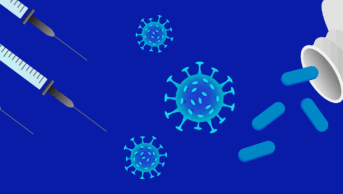The human genome — the collected blueprint of our heredity — is a remarkable piece of biological engineering. DNA represents the language of the information encoding the genome, which translates into genes, some of which subsequently code for specific proteins and shape important biochemical processes. The translation of DNA to protein expression is modified and controlled by countless biological actions often too varied and complex for us to comprehend.
The age of genomics — the study of the genome — continues at a pace with its focus on how various genetic mutations (eg, single nucleotide polymorphisms, copy number variants) shape our predisposition to numerous conditions impacting on our physical and psychological health.
The rise of epigenetics1 — the science of changes to gene function not explained by structural changes to the genome — further adds to the complexity and emphasises how our genes are continually interacting with the environment around us. Far from being static entities, our genes are dynamic, variably switching on and off as a function of various different genetic, biochemical and environmental processes.
Although science is beginning to make in-roads into the complexity of how our genes shape our lives, curious things are also turning up in the genome. Regions of the genome, thought to contain only “junk DNA”, might not be so redundant as once thought. Even more surprisingly, our genomes might carry the battle scars of our evolutionary war with the forces of nature. In short, we are all hosts to viruses and hence, we are all part virus.
An absorbing process
Indeed, these additions to the genome are our spoils of conquest following generations of our ancestors at war with a multitude of microscopic viral invaders.
The constant bombardment of viral pathogens that the human race has fought off and developed immunity against down the ages has not been without consequences to our genome, as illustrated by the increasing interest in the role of endogenous retrovirus (ERVs) fragments and elements in health and disease.
Human endogenous retroviruses (HERVs) are the remnants of ancient retroviral infections, sometimes called fossil viruses, marked into our DNA via infection of germline cells (ie, the cells involved in reproduction).2 Passed down the generations, retroviral genes become part of the host genome and, gradually, generation after generation, pick up genetic mutations which eventually inactivate the virus, although still, in some cases, carrying the essential viral genes noted in exogenous retroviruses such as HIV. Around 4–8 per cent of the human genome is thought to comprise HERVs.3
Jumping genes
HERVs are part of the human mobile retrotransposon families or “jumping genes”. The idea that sequences of DNA might be mobile is perhaps one of the more surprising things about our genome. Indeed, this is all the more surprising when one discovers that such transposable elements may also be able to affect the function and expression of nearby genes depending on where they find themselves in the genome.4
Drawing on the increasing interest in the science of epigenomics, there is a growing acceptance that certain HERVs are, to some degree, kept in check by an epigenetic action. Depending on whether the long terminal repeats — the long, repeating sequences of DNA found at the ends of retrotransposons — are methylated or not, for example,5 seems to influence the subsequent effect on surrounding genes.
HERVs and health
It is still early days in terms of the research looking at how the expression of HERVs might influence health and well-being, although several themes have already emerged with regard to a possible action. Nelson and colleagues6 summarised some of the potentially important effects of HERVs listing them as potential modulators of gene or protein expression; potential superantigens, or potential agents of molecular mimicry, hence a candidate mechanism for the presentation of autoimmune conditions.
Looking specifically at the issues of molecular mimicry or HERVs as superantigens and onwards autoimmunity, Tugnet and colleagues7 provide an excellent overview looking specifically at the details of HERVs as possible triggers of autoimmune rheumatic disease. One particular theme is that of loss of tolerance — a key point in autoimmunity where the body fails to differentiate between self and foreign organisms. Although further investigation is indicated, one theory is that HERVs provide a continual source of antigen, fuelling an immune response as a consequence of cross-reactivity with self-proteins.
As previously indicated, the role of an epigenetic influence on HERV expression may also play an important role in their link to autoimmune diseases. Nakkuntod and colleagues8 reported results based on the examination of methylation status of two HERVs — HERV-E and HERV-K — in lymphocytes from patients with systemic lupus erythematosus (SLE). They found that hypomethylation was a feature for SLE patients. The implication is that lower methylation levels will allow for expression of HERV genes, which may then have knock-on effects for processes such as molecular mimicry.
Various other conditions have also implicated HERVs as potential agents in their onset. Cancer research has, to some extent, taken on board the potential for HERVs to influence health.9 Reis and colleagues10 suggested that one particular class of HERV — a class II HERV-K element — related to betaretroviruses was frequently expressed in prostate cancer tissue specimens they analysed. They also noted that demethylation and androgen stimulation were regulators of gag-HERV-K protein expression and concluded that their findings were evidence of “one of the first bona fide retroviral cancer antigens in humans”. Similar results have been reported for other classes of HERVs, including in relation to gastrointestinal cancers11 and breast cancer.12
Some surprising HERV links
There is also a growing body of research literature suggestive of a link between HERVs and a variety of idiopathic conditions where genetics and biochemistry have not been fully elucidated. De Meirleir and colleagues13 reported preliminary results of immunoreactivity to HERV proteins in duodenal biopsies taken from patients diagnosed with myalgic encephalomyelitis (ME). They speculated that HERV expression may also have some connection to the expression of pro-inflammatory cytokines noted in cases of ME and some involvement with, or as a consequence of, the appearance of chronic inflammation.
HERVs have also been implicated in cases of schizophrenia and bipolar disorder. Perron and colleagues14 suggested that a specific HERV — HERV-W — may lie at an important intersection “between environmental, genetic and immunological factors” in relation to symptom onset. They suggested that activation of HERV-W by means of specific infections may have subsequent knock-on effects again with regard to inflammation and immune activation.
Other studies have also reported over-expression of other HERVs — HERV-H — in relation to conditions such as attention deficit-hyperactivity disorder15 and autism spectrum disorder.16 Although, again, there are still gaps in our knowledge of how HERVs may be related to these conditions and, indeed, any other comorbid conditions potentially present, it is interesting to note the results from Shuvarikov and colleagues17 pointing to a possible role for HERVs in mediating a genetic deletion which coincided with the appearance of autistic behaviours and other cognitive and development features.
Conclusions
There is a growing scientific interest in fossil viruses and how they may impact on health and well-being. Although a lot of focus has been directed to their relationship to the onset or progression of various diseases or conditions, it is likely that HERVs play a more multifactorial role purely as a consequence of their abundance in the genome and expression during important periods of development. Evidence for the mechanisms of how HERVs may link to specific conditions or states is accumulating based on central themes of their connection to immune function and perhaps more fundamental effects on the genome itself. More than that, however, HERVs provide us with an important link to our distant ancestors and illustrate how, from our basic understanding of our genome, our biological blueprint is turning out to be even more complicated than anyone could have ever imagined.
Kalliopi Dodou is senior lecturer in pharmaceutics, Sunderland Pharmacy School, University of Sunderland.
Paul Whiteley is a researcher based in the north east of England.
Correspondence to: Kalliopi Dodou (email kalliopi.dodou@sunderland.ac.uk)
References
1 Dodou K. Whiteley P. DNA not necessarily your destiny? The growing role of epigenetics in pharmacy. The Pharmaceutical Journal 2013;290;23–4.
2 Griffiths DJ. Endogenous retroviruses in the human genome sequence. Genome Biology 2001:2:1017.
3 Lander ES, Linton LM, Birren B et al. Initial sequencing and analysis of the human genome. Nature 2001;409:860–921.
4 Slotkin RK, Martienssen R. Transposable elements and the epigenetic regulation of the genome. Nature Reviews Genetics 2007;8:272–85.
5 Lavie L, Kitova M, Maldener E et al. CpG methylation directly regulates transcriptional activity of the human endogenous retrovirus family HERV-K(HML-2). Journal of Virology 2005;79:876–83.
6 Nelson PN, Hooley P, Roden D et al. Human endogenous retroviruses: transposable elements with potential? Clinical and Experimental Immunology 2004;138:1–9.
7 Tugnet N. Rylance P, Roden D et al. Human endogenous retroviruses (HERVs) and autoimmune rheumatic disease: is there a link? The Open Rheumatology Journal 2013;7:13–21.
8 Nakkuntod J, Sukkapan P, Avihingsanon Y et al. DNA methylation of human endogenous retrovirus in systemic lupus erythematosus. Journal of Human Genetics 2013;58:241–9.
9 Yu HL, Zhao ZK, Zhu F. The role of human endogenous retroviral long terminal repeat sequences in human cancer (Review). International Journal of Molecular Medicine 2013;32:755–62.
10 Reis BS, Jungbluth AA, Frosina D et al. Prostate cancer progression correlates with increased humoral immune response to a human endogenous retrovirus GAG protein. Clinical Cancer Research 2013;19:6112–25.
11 Wentzensen N, Coy JF, Knaebel HP et al. Expression of an endogenous retroviral sequence from the HERV-H group in gastrointestinal cancers. International Journal of Cancer 2007;121:1417–23.
12 Wang-Johanning F, Li M, Esteva FJ et al. Human endogenous retrovirus type K antibodies and mRNA as serum biomarkers of early-stage breast cancer. International Journal of Cancer 2014;134:587–95.
13 De Meirleir KL, Khaiboullina SF, Frémont M et al. Plasmacytoid dendritic cells in the duodenum of individuals diagnosed with myalgic encephalomyelitis are uniquely immunoreactive to antibodies to human endogenous retroviral proteins. In Vivo 2013;27:177–87.
14 Perron H, Hamdani N, Faucard R et al. Molecular characteristics of human endogenous retrovirus type-W in schizophrenia and bipolar disorder. Translational Psychiatry 2012;2:e201.
15 Balestrieri E, Pitzianti M, Matteucci C et al. Human endogenous retroviruses and ADHD. The World Journal of Biological Psychiatry 2013 28 Nov 2013. [Epub ahead of print].
16 Balestrieri E, Arpino C, Matteucci C et al. HERVs expression in autism spectrum disorders. PLoS One 2012;7:e48831.
17 Shuvarikov A, Campbell IM, Dittwald P et al. Recurrent HERV-H-mediated 3q13.2-q13.31 deletions cause a syndrome of hypotonia and motor, language, and cognitive delays. Human Mutations 2013;34:1415–23.


